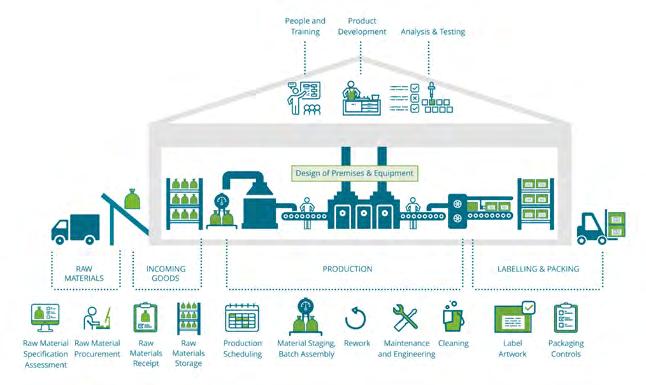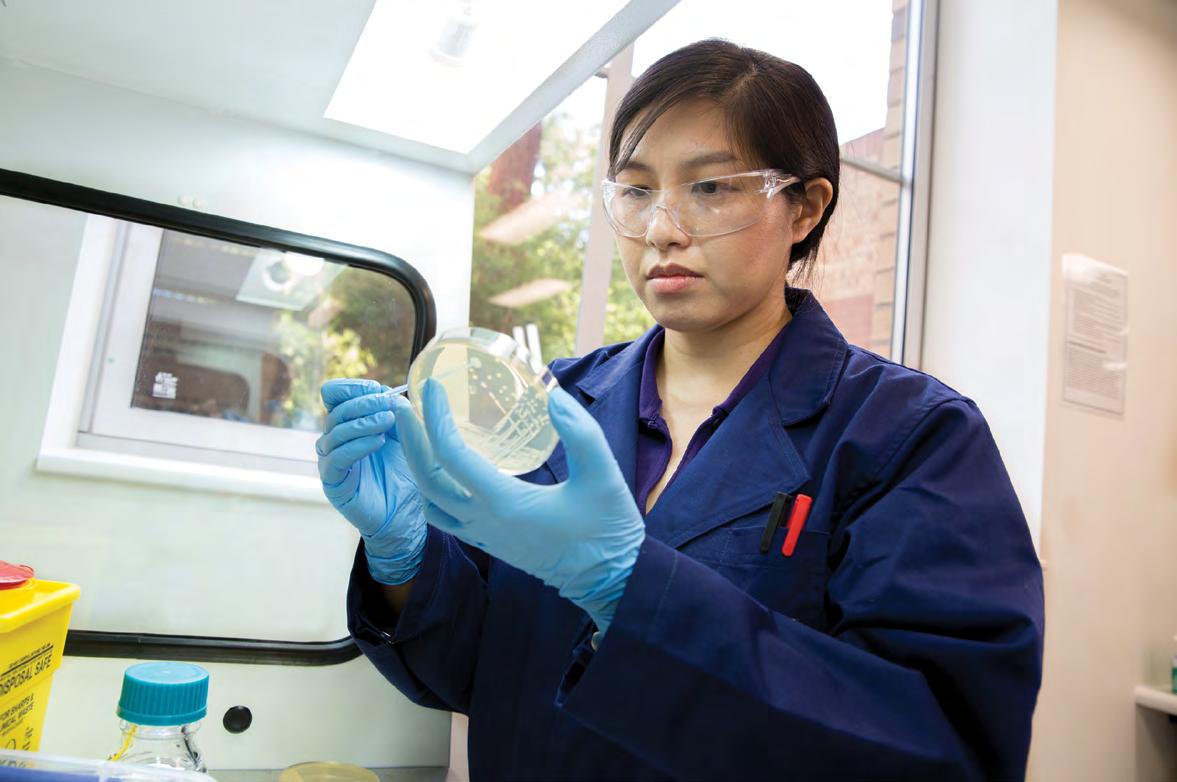
10 minute read
Allergen management resources
Words by Debbie Hawkes
Incidents involving food allergens are an increasing international phenomenon and the leading cause of food recalls in Australia and
New Zealand. In 2018, undeclared allergens made up 46 per cent of
Australian recalls and, at the time of writing, 53 per cent of New Zealand recalls in 2019 were from undeclared allergens. Most of these recalls are due to packaging errors or supplier verification issues.
Navigate the science
VITAL ® Program and VITAL Scientific Expert Panel
The Allergen Bureau’s VITAL ®
(Voluntary Incidental Trace Allergen Labelling) Program is a standardised allergen risk assessment process for the food industry. VITAL uses a consistent science-based approach, with scientifically derived allergen reference doses forming the basis of deciding the appropriateness of precautionary allergen labelling in foods that contain allergen food residues in the form of cross contact.
Scientific evidence has shown there are levels of allergenic food residues that are small enough not to trigger an allergic reaction in most individuals with a food allergy under normal circumstances. Recognising a need for these levels to be identified through sound and robust science, the Allergen Bureau invited international scientists specialising in allergen management, food allergy and risk assessment to form the VITAL Scientific Expert Panel (VSEP).
The objective of the VSEP is to review the underpinning science around food allergen thresholds and reference doses. The recommendations from the VSEP form the scientific framework for the VITAL Program. 2
VSEP 2019 reference doses - VITAL 2.0 to VITAL 3.0
At FAMS2019, members of the VSEP, Professor Steve Taylor [Food Allergy Research & Resource Program (FARRP), University of Nebraska and VSEP Chair] and Dr Ben Remington [Netherlands Organisation for Applied Scientific Research (TNO)], presented new research on allergen threshold modelling and the resulting updated set of food allergen reference doses. A summary description of the methodology applied in the determination of the updated reference doses is provided in the Summary of the 2019 VITAL Scientific Expert Panel Recommendations available on the Allergen Bureau website. 3
The previous reference dose recommendations (VITAL 2.0) used three discrete models (Weibull, Log Logistic and Log Normal) and eliciting
doses (EDp) were identified by ‘expert judgement’ of the best fit from the three models in the relevant low dose section of the model.
The Panel advised that ongoing collaboration between FARRP, TNO and Dr Matthew Wheeler, US CDC [National Institute for Occupational Safety and Health (NIOSH)] to improve the allergen dose distribution modelling has resulted in the development of a new ‘stacked model averaging’ program. 4 This program incorporates five different statistical models (Weibull, Log Logistic, Log Normal, Log Double Exponential, General Pareto) and produces a single ‘averaged’ distribution. The stacked model averaging program produces a single curve for each allergen from which eliciting doses may be derived. The VSEP identified the ED01 and ED05 for each allergen. The Panel considered the more conservative estimate to be appropriate after fitting the data to both discrete and cumulative dosing schemes. 5 The Panel considered that ED01 better met the requirements of the Allergen Bureau which included: minimising the percentage of the allergic population at risk from cross contact allergens in unlabelled products; increasing the likelihood of global acceptance of VITAL; and a level of risk no greater than VITAL 2.0. Additionally, ED05 values are also provided for information (Table 1). Sufficient data were available for egg, hazelnut, lupin, milk, mustard, peanut, sesame, shrimp, soy, wheat, cashew, celery, fish and walnut.

The interactive Allergen Risk Review website is based around a schematic factory map to show allergen impacts and provides reassurance for risk review decisions and assumptions.
There was a significant increase in the number of individuals who had undergone challenge studies for most allergens and also, therefore, the number of data points available for dose distribution modelling. As with the 2011 recommendations, all the data from adults were derived from double blind placebo controlled food challenges, 6 whereas blinding was not considered absolutely necessary in the case of data from infants and very young children on the basis of clinical opinion. The following Allergen Bureau activities have occurred to facilitate the transition from VITAL 2.0 to the new science of VITAL 3.0: • Update the food industry guide to allergen management and labelling for Australia and New Zealand • Update the food industry guide to the VITAL Program to version 3.0 • Enhance VITAL Online functionality to assist change management (update all recipes, summary of recipes by allergen status, recipe change history) • Update the VITAL training package to include VITAL 3.0
The Allergen Bureau encourages VITAL users to be aware of the reference dose changes, and review the impact these changes may have on risk assessments and labelling. It is important to emphasise that the process of doing an overall risk review and a VITAL risk assessment does not change. The basis of the VITAL Program continues to be good risk review and good manufacturing processes (GMP).
Who is the Allergen Bureau?
Established in 2005, the Allergen Bureau is a membership-based organisation that works on behalf of the food industry to address many of the causes of allergen related food recalls. The Allergen Bureau operates primarily through promotion of best practice allergen risk assessment and management, to help food manufacturers provide allergen sensitive consumers with relevant, consistent and easy to understand food allergen information. The Allergen Bureau operates through a board of directors who volunteer their time, with the support of their companies, to govern the organisation and actively manage and contribute to projects. The expertise of scientific and technical consultants and a funded secretariat provides the support network to deliver Allergen Bureau industry initiatives. Current membership is comprised of one global full Member, 34 full members, 37 associate members and 48 individual members - a total of 120 members. The Allergen Bureau’s vision of being a globally recognised organisation is supported by Allergen Bureau website visitation data, showing that more than 50 per cent of users and sessions on the Allergen Bureau website come from outside of Australasia.
Manage the risk
While the Allergen Bureau helps the food industry navigate the science of food allergens, by organising events such as FAMS2019 and collaborating with international researchers such the VSEP, we also work to provide information and resources that help industry better manage the risk from allergens, particularly in support of the VITAL Program. • The VITAL Program is supported by a broad framework of Allergen
Bureau initiatives including: • A free email and phone helpline service – call +61 437 918 959 or email info@allergenbureau.net • Monthly Allergen Bureau eNews - circulated to more than 8000 people, covering the latest industry news and information • VITAL training providers - 19 endorsed training providers from many regions globally • VITAL Online (the user-friendly, web-based VITAL calculator) to record the VITAL risk assessment, including calculation of action levels incorporating the VSEP recommended reference doses, leading to a finished product labelling outcome • Collaboration with, and submissions to, such key agencies such as
FSANZ and the Codex Alimentarius
Commission • Working Groups: risk review; risk communication (labelling); VITAL certification; cross contact risk review anomalies; and agricultural allergen cross contact The Allergen Bureau working groups play a significant role in helping industry manage food allergen risks. They provide a collaborative approach to addressing allergen issues at the pre-competitive stage, with each group helping to take forward key areas identified for development.
Allergen risk review website
The interactive allergen risk review website is designed to guide the user through conducting a best practice allergen risk review. It is expandable to include the entire supply chain, from primary production to finished
Table 1 – VSEP 2019 Recommended Reference Doses (mg protein)
Allergen
Egg Hazelnut Lupin Milk Mustard Peanut Sesame Shrimp Soy (milk + flour) Wheat Cashew Celery Fish Walnut
No. of individuals
431 411 25 450 33 1306 40 75 87 99 245 82 82 74
VITAL 2.0 Ref Dose (mg protein)
2019 VSEP Ref Dose (mg protein) [ED0 1 ] = VITAL 3.0 0.2 0.1 2.6 0.2 0.05 0.2 0.1 25 0.5 0.7 0.05 0.05 1.3 0.03 Change 2019 VSEP (mg protein) [ED0 5 ]
Reference Dose increased, Reference Dose unchanged, Reference Dose decreased, + New Reference Dose Source: Summary of the 2019 VITAL Scientific Expert Panel
product and it is easy to use, with the ability to focus on specific areas of concern. This website is freely available, linked from the Allergen Bureau website, and is a very visual tool based around a schematic factory map (Figure 1) to show allergen impacts and provides reassurance for risk review decisions and assumptions.
Allergen risk review anomalies
The Allergen Bureau has been collaborating with the Ai Group, AFGC, ANZ jurisdictions, Allergy NZ, and Allergy & Anaphylaxis Australia to determine consensus on the issue of allergen risk review anomalies. An allergen risk review anomaly is defined as allergens known to be present at significant levels but not formulated as an ingredient, and therefore inappropriate to label as “May be present: allergen x”. This scenario can occur when every attempt has been made to effectively eliminate the allergen, but the process or environment cannot be altered or impacted through GMP (such as milk or dairy in dark chocolate blended in the same conch). A set of key guiding principles and a decision tree have been developed to help affected companies. This industry guidance has been published to ensure appropriate labelling for the allergic consumer, which may involve declaring the allergenic substance, such as milk for example, as the last ingredient. It is important to note that the decision tree must not be used as a substitute
for appropriate risk review and GMP.
The ‘VITAL Standard’ for certification
Allergic consumers do not currently have information to confirm whether a product has undergone a robust VITAL risk assessment and therefore whether they can trust the allergen and precautionary allergen labelling. The VITAL Standard and certification process has been developed to address concern amongst allergy consumer groups by providing external verification of specific products. The VITAL Standard has been written in compliance with ISO 17065 and has been designed as an extra module for sites certified to a GFSIrecognised food safety management scheme with HACCP based allergen management programs. VITAL certification is site and product specific and will include an optional
on-pack VITAL mark next to the ingredient list as an endorsement of the integrity of the allergen labelling. All VITAL Standard certified products will be registered by the Allergen Bureau and listed on their website.
Agricultural allergen cross contact
In response to detections of allergens in agricultural crops (such as peanut in garlic and lupin in wheat), a working group has been formed to identify and communicate the challenges. Work is in progress to update the Allergen Bureau’s Unexpected Allergens in Food publication, develop an agricultural cross contact issue flow chart, define sampling and testing guidance, and establish better cross sectoral working relationships. Ultimately, this working group aims to publish a Food Industry Guide to Agricultural Allergen Cross Contact Management. The Allergen Bureau will continue to communicate about food allergen science and risk management via our website and eNews, and at conferences such as FAMS. We will maintain collaboration with key stakeholders via our working groups, and we will continue to invest in resources that support best practice allergen management such as the VITAL Program. And while we look toward increasing the proportion of users of the VITAL Program outside of Australia and New Zealand, the Allergen Bureau will always work to maintain and improve our core commitment of informing the local ANZ food industry.
References
1. Allergen Bureau, 2019 Conference Presentations http:// allergenbureau.net/resources/ conference-presentations/2019- conferencepresentations/ - date sourced 25 Sep 2019 2. Allergen Bureau, VITAL Science http:// allergenbureau.net/vital/vitalscience/ - date sourced 25 Sep 2019 3. Allergen Bureau, Summary of the 2019 VITAL 4.
5. 6. Scientific Expert Panel Recommendations http://allergenbureau.net/vital/vital-science/ - date sourced 25 Sep 2019 Wheeler MW, Westerhout J, Baumert JL, Remington BC. Bayesian Stacked Parametric Survival with Frailty Components and Interval Censored Failure Times. August 2019. http:// arxiv.org/abs/1908.11334 Remington et al, in prep. Westerhout J, Baumert JL, Blom WM, Allen KJ, Ballmer-Weber B, Crevel RWR, Dubois AEJ, Fernández-Rivas M, Greenhawt MJ, O’B Hourihane J, Koplin JJ, Kruizinga AG, Le T-M, Sampson HA, Shreffler WG, Turner PJ, Taylor SL, Houben GF, Remington BC, Deriving individual threshold doses from clinical food challenge data for population risk assessment of food allergens, Journal of Allergy and Clinical Immunology (2019), doi: https://doi. org/10.1016/j. jaci.2019.07.046.
Debbie Hawkes, FNZIFST, is Director of The Allergen Bureau and General Manager of Hawkins Watts (Operations and Quality, ANZ). This article is based on Debbie Hawkes’ presentation at the NZIFST Conference, Good Food 4, in July 2019, and printed in the October/ November 2019 issue of Food New Zealand f











